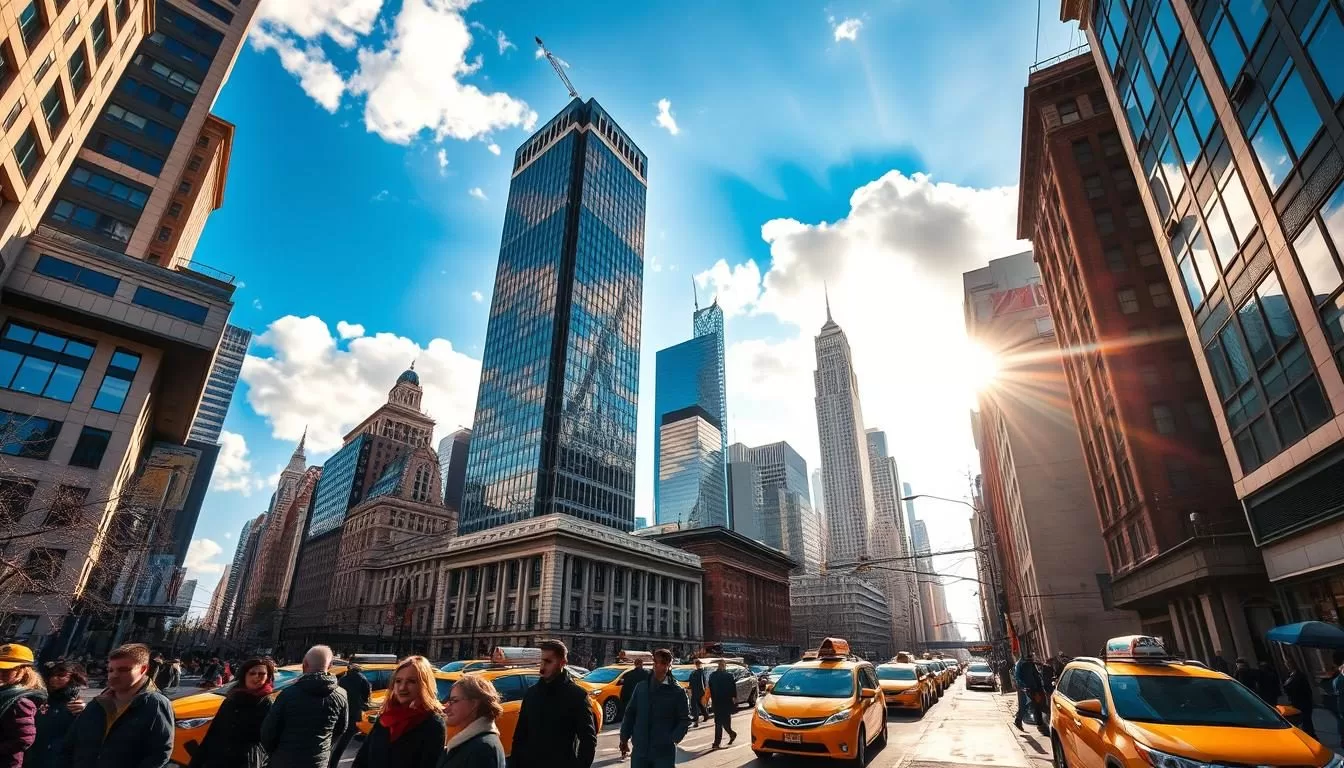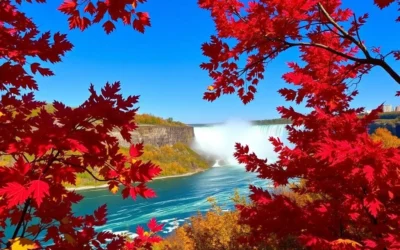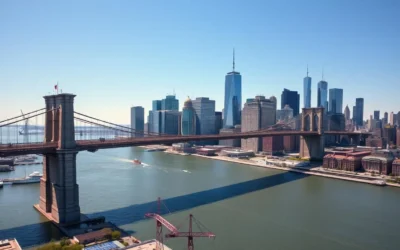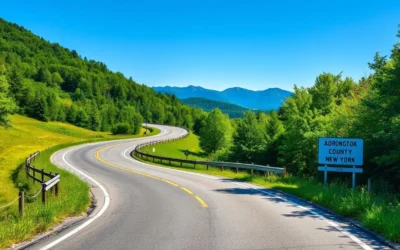Visiting New York City can be a fantastic experience, but the weather can greatly impact your trip. Understanding the city’s weather patterns is crucial to making the most of your visit.
The city’s climate varies significantly throughout the year, from sweltering summers to freezing winters. Knowing what to expect during your visit can help you plan a better trip and avoid weather-related disappointments.
In this guide, we’ll explore the best time to visit New York based on weather preferences and activities you want to enjoy. Whether you’re looking for pleasant spring weather or festive winter activities, we’ll help you plan a weather-savvy trip to this vibrant city.
Understanding New York City’s Climate
Understanding the climate in New York City is key to making the most of your visit. The city’s weather is a complex mix of varying temperatures and precipitation levels throughout the year.
Climate Fast Facts and Key Statistics
New York experiences a humid subtropical climate with significant seasonal variation. Rainfall is consistent throughout the year, with no dry season. Key statistics include an average annual rainfall of 49 inches.
Average Monthly Temperature Patterns
Temperature in New York City varies significantly across the year. Summer months are warm, with temperatures often in the 80s (°F), while winter months can be cold, with temperatures sometimes below freezing.
Precipitation and Daylight Hours Throughout the Year
The weather in New York is characterized by varying precipitation and daylight hours. Summer months, especially June, are the wettest. Daylight hours vary, with the longest in June and shortest in December. This affects your planning and time management during the season.
- Rainfall is a significant factor in New York City‘s climate, with June being the wettest month.
- Daylight hours change dramatically from season to season, affecting sightseeing opportunities.
Spring in New York City: March to May
As the winter chill begins to dissipate, New York City transforms into a vibrant spring destination. The city’s energy becomes more palpable as the weather improves, making it an ideal time to visit.
Temperature and Rainfall Expectations
During spring, New York experiences mild temperatures, ranging from the mid-50s to the mid-70s Fahrenheit. You can expect some rainfall, but it contributes to the city’s lush greenery. Average rainfall in spring is around 3-4 inches per month.
Spring Events and Celebrations
Spring in York City is marked by various events and celebrations. You can enjoy the spring festivities, including Easter Parade, Cherry Blossom Festival, and various cultural events. These events add to the city’s vibrancy and provide a unique experience for visitors.
Advantages of Visiting During Spring
Visiting New York during spring has several advantages. It’s a good time visit the city as it’s less crowded and cheaper. You can find better deals on hotels and flights, and attractions are less busy. The gradually improving weather opens up more outdoor opportunities, making it an ideal trip to the Big Apple. Here are some benefits:
- Lower hotel rates and better availability
- Shorter lines at attractions
- Easier reservations at popular restaurants
- The city’s natural beauty transforms with flowering trees and revived neighborhood gardens
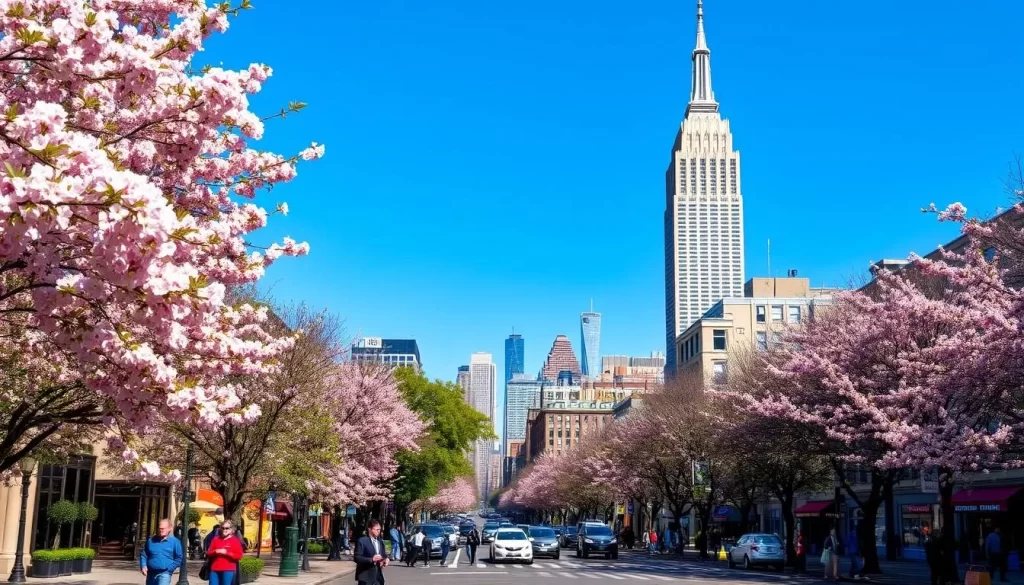
Summer Season Essentials: June to August
New York City summers are known for their sweltering heat and humidity, but with the right preparation, you can navigate the season with ease. Summer is the busiest time in New York City, with many people coming to enjoy the weather and long days.
Managing the Summer Heat and Humidity
To beat the heat, stay hydrated by drinking plenty of water and take breaks in air-conditioned spaces. Wear lightweight, breathable clothing to keep cool. You can also enjoy summer activities like visiting rooftop bars or taking a stroll along the High Line.
Summer Activities and Packing Tips
Summer in New York offers a wide range of activities, from outdoor concerts to visiting iconic landmarks. When packing, don’t forget to include sunscreen, sunglasses, and a hat to protect yourself from the sun. A table summarizing essential items to pack is provided below:
| Item | Description | Importance Level |
|---|---|---|
| Sunscreen | Protects skin from UV rays | High |
| Sunglasses | Protects eyes from glare | High |
| Lightweight Clothing | Keeps you cool in the heat | Medium |
| Comfortable Shoes | Essential for walking around the city | High |
Dealing with Tourist Crowds
To avoid long waits at popular spots, plan your visits during off-peak hours or consider visiting lesser-known alternatives. Understanding reservation systems and timed entry tickets can also help you secure access to must-see attractions despite the crowds. By managing your time effectively, you can enjoy the best of New York City without the hassle.
Fall: The Golden Season: September to November
Autumn in New York City is a magical time, with the city’s landscapes turning into a kaleidoscope of colors. As Albert Camus once said, “Autumn is a second spring when every leaf is a flower.” This quote perfectly captures the essence of fall in the Big Apple.
Fall Foliage and Weather Conditions
During the fall season, New York City experiences mild temperatures, ranging from the mid-50s to the mid-60s Fahrenheit. The comfortable weather, coupled with the vibrant foliage, makes it an ideal time to explore the city’s outdoor attractions.
Autumn Events and Festivals
Fall in New York is not just about the weather; it’s also a time for various events and festivals. The city hosts numerous autumn-themed events, including the New York Film Festival and the US Open Tennis Tournament. These events add to the city’s vibrancy and offer something for everyone.
Why Fall Is a Favorite Among Travelers
Many travelers prefer visiting New York City during the fall because it offers a perfect balance of pleasant weather, exciting events, and manageable crowd sizes. The fall season allows visitors to enjoy the city’s attractions without the overwhelming crowds of the summer months.
| Month | Average Temperature | Events |
|---|---|---|
| September | 64°F | US Open Tennis Tournament |
| October | 58°F | New York Film Festival |
| November | 50°F | Macy’s Thanksgiving Day Parade |
Winter Adventures in NYC: December to February
As the calendar flips to winter, New York City transforms into a magical wonderland, full of festive experiences and winter adventures. You can enjoy the city’s iconic holiday markets, ice skating rinks, and dazzling light displays.
Holiday Season Weather Considerations
During the holiday season, New York experiences cold weather, with average temperatures ranging from 25°F to 45°F (-4°C to 7°C). You should pack warm clothing, including coats, gloves, and scarves, to stay cozy while exploring the city.
Winter Activities and Preparation
Winter in New York City offers a variety of activities, such as ice skating at Rockefeller Center, visiting the Christmas markets, and taking a stroll through the snow-covered landscapes of Central Park. To make the most of your trip, prepare by booking popular attractions and shows in advance.
| Activity | Location | Time |
|---|---|---|
| Ice Skating | Rockefeller Center | All day |
| Christmas Markets | Various Locations | Day and Evening |
| Central Park Stroll | Central Park | Daytime |
Post-Holiday Travel Benefits
After the holiday rush, you can enjoy New York with fewer crowds and lower prices for hotels and flights. This is a great time to explore the city like a local, discovering new neighborhoods and trying different cuisines in various ways.
New York, United States: Best Months for a Weather-Savvy Trip
For a weather-savvy trip to New York, choosing the right time is essential for a comfortable and enjoyable experience. The city’s climate varies significantly throughout the year, making some months more favorable for visiting than others.
Prime Months for Comfortable Weather
The spring and fall seasons in New York City offer the most comfortable weather, with mild temperatures and fewer extremes. During these periods, you can enjoy outdoor activities and iconic landmarks without the harsh weather conditions of other seasons. Spring, from March to May, brings blooming gardens and pleasant temperatures, while fall, from September to November, offers a comfortable coolness after the summer heat.
![]()
Shoulder Season Benefits
Visiting New York during the shoulder seasons—late spring and early fall—comes with several benefits. You can expect lower hotel rates and better flight prices, making your trip more budget-friendly. Additionally, these periods offer a more authentic experience of the city, with a better balance between tourists and locals, and easier access to popular attractions without the peak season crowds.
By choosing to visit during these shoulder seasons, you can maximize your travel budget while enjoying excellent weather conditions and a more relaxed experience at popular spots.
Impact of Weather on Major NYC Attractions
New York City’s diverse weather conditions can either enhance or hinder your visit to its iconic attractions. The city’s weather varies significantly across seasons, influencing the experience at outdoor and indoor attractions.
Outdoor Landmarks and Seasonal Considerations
Outdoor landmarks like the Statue of Liberty, Central Park, and Times Square are affected by the weather. During harsh winters or sweltering summers, the experience at these locations can be less enjoyable. In contrast, spring and fall offer mild temperatures, making them ideal for visiting outdoor attractions. You can enjoy a stroll in Central Park during spring or witness the fall foliage.
| Attraction | Best Season | Weather Consideration |
|---|---|---|
| Statue of Liberty | Spring/Fall | Avoid harsh weather |
| Central Park | Spring/Summer | Enjoy mild temperatures |
| Times Square | All Year | Be prepared for crowds |
Indoor Alternatives During Inclement Weather
When the weather is not favorable, New York City’s world-class indoor attractions come to the rescue. You can visit museums like the Met or the American Museum of Natural History, catch a Broadway show, or explore shopping destinations like the Mall at the World Trade Center. These indoor activities allow you to enjoy the city’s culture without being affected by the weather.
Some indoor activities worth prioritizing include visiting the Museum of Modern Art (MoMA), taking an indoor tour at the Brooklyn Museum, or enjoying the iconic department stores like Saks Fifth Avenue.
- Visit museums and galleries
- Catch a Broadway show
- Explore indoor shopping centers
Transportation Considerations in Different Seasons
As the seasons change, so do the best ways to travel in New York City. Understanding how weather affects your transportation options can make a significant difference in your travel experience.
Weather Effects on Subway and Walking
New York City’s subway system is generally reliable, but extreme weather conditions like heavy rain or snow can cause disruptions. Walking is another popular way to get around the city, but it can be challenging during harsh weather. For instance, icy sidewalks in winter or sweltering heat in summer can impact your time spent exploring.
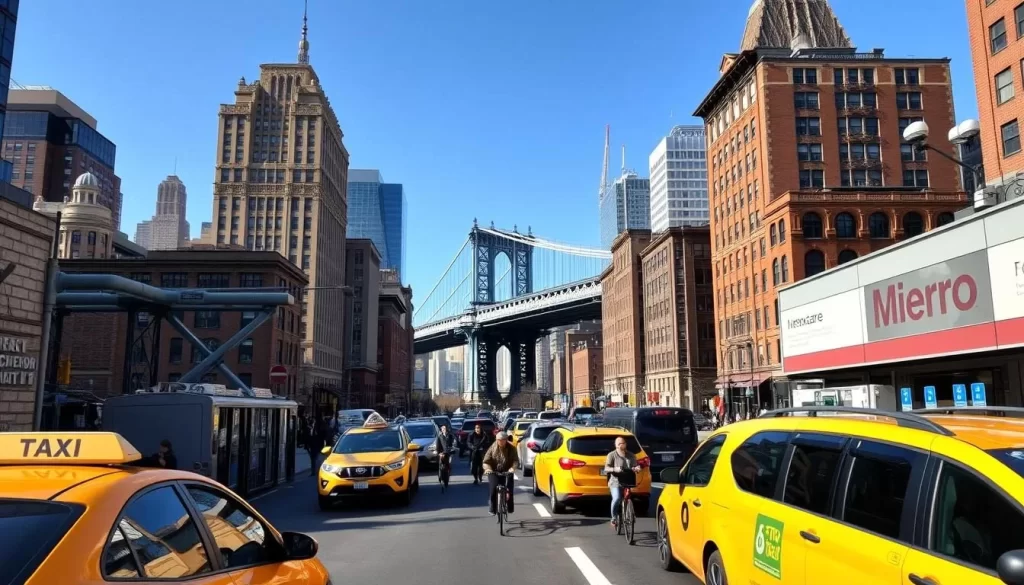
Alternative Transportation Options
Fortunately, there are numerous alternative transportation options in New York City. Taxis and ride-sharing services like Uber or Lyft are always available, making them ideal for bad weather. Cyclists might appreciate the East River Ferry, which allows bikes for a small extra charge and offers stunning views of the city‘s waterfront. Exploring these ways to travel can enhance your New York experience.
By considering these alternatives, you can navigate the city more comfortably and efficiently, regardless of the season.
Budget-Friendly Travel Across Seasons
Making the most of your trip to New York without overspending requires some knowledge of the best times to travel. You can enjoy the city’s attractions and activities while keeping your expenses in check by understanding how prices vary across different seasons.
Accommodation Price Variations by Season
Accommodation prices in New York fluctuate significantly with the seasons. During peak travel seasons like summer and holidays, hotels and rentals tend to be more expensive. In contrast, the shoulder season, which includes periods like mid-January to mid-March and September to November, often offers more competitive pricing. Planning your trip during these times can lead to significant savings. For instance, you might find discounts on hotels in areas outside of Manhattan or package deals that include access to major attractions.
Finding Deals on Flights and Attractions
To save on flights to New York, consider traveling during off-peak times, such as mid-week or during the off-season. Flight prices tend to be lower during these periods. Additionally, look out for discounted attraction days and city passes that can offer substantial savings on activities and entry fees. Many attractions provide free or discounted entry on certain days of the week or month. By timing your visits strategically, you can enjoy the city’s offerings without breaking the bank.
Beyond Manhattan: Weather in the Five Boroughs
Exploring the five boroughs of New York City reveals diverse microclimates that can significantly impact your travel experience. While Manhattan often takes center stage, the other boroughs – Brooklyn, Queens, the Bronx, and Staten Island – each have their own weather charm, influenced by their unique geography and infrastructure.
Microclimate Variations Across NYC
New York City’s five boroughs experience varied microclimates due to their different locations and infrastructures. For instance, Staten Island tends to be cooler in the summer due to its proximity to the Atlantic Ocean, while the Bronx might experience slightly cooler temperatures compared to the more urban areas like Manhattan. Understanding these microclimates can help you plan your activities and make the most of your visit.
- Staten Island benefits from sea breezes, making it a cooler destination during the summer.
- The Bronx, with its more suburban areas and parks, can be a refreshing escape from the urban heat.
- Brooklyn and Queens, with their coastal exposure, experience a mix of urban and maritime weather influences.
Borough-Specific Weather Considerations
Each borough’s unique characteristics mean that weather can affect them differently. For example, areas with more green spaces like the Bronx may be cooler during heatwaves, while coastal areas like Brooklyn and Queens may experience more pronounced sea breeze effects. Being aware of these differences can enhance your experience, whether you’re visiting the Statue of Liberty or exploring the Bronx Zoo.
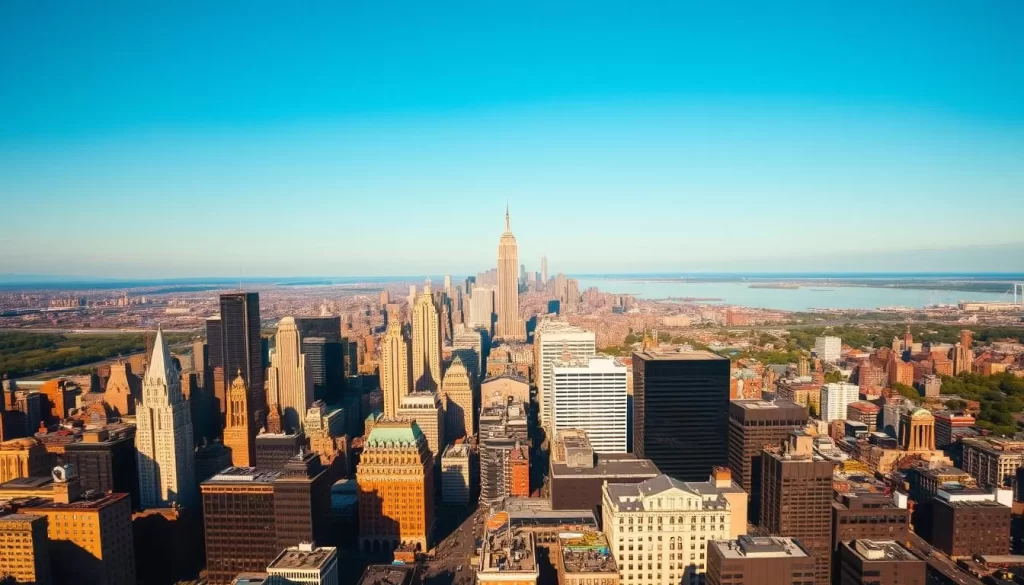
By understanding the local weather patterns, you can create a more tailored itinerary that takes advantage of the best conditions in each borough, ensuring a more enjoyable and memorable trip to the Big Apple.
Conclusion
With the knowledge of New York‘s climate, you’re now ready to plan your trip with confidence. You’ve gained a comprehensive understanding of how New York City‘s weather patterns affect the visitor experience throughout the year.
Each season offers a unique experience, from summer’s energy to winter’s magic and the balanced appeal of spring and fall. Consider your preferences for weather, crowds, and budget when choosing your travel dates to the Big Apple.
This information helps you set realistic expectations and prepare for your chosen season, ensuring an amazing New York experience. You’re now equipped to be a truly weather-savvy traveler, making your trip as enjoyable as possible.
The above is subject to change.
Check back often to TRAVEL.COM for the latest travel tips and deals.
Here are some Tours & Sightseeing suggestions that might pique your interests!
